
march 20
from a snow-covered tree
one bird singing
each tweet poking
a tiny hole
through the edge of winter
and landing carefully
balancing gently
on the tip of springmarch 22
just like a tiny, blue hello
a crocus blooming
in the snow
I can’t think of a better way to kick off National Poetry Month and celebrate Spring than with these beautiful poems by Julie Fogliano, the first two in her brand new book, When Green Becomes Tomatoes: Poems for All Seasons (Roaring Brook Press, 2016), illustrated by Julie Morstad.

She pretty much had me at “each tweet poking/a tiny hole/through the edge of winter,” and I continued to swoon as I carefully made my way through the entire book, which features about a dozen enchanting poems for each season, presented as dated entries in a nature journal, beginning and ending with March 20, the Spring equinox.
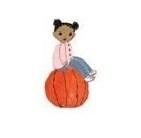 These spare and lyrical free verse observations are told in an intimate, conversational voice, describing subtle and not-so-subtle seasonal changes with regard to wind, rain, earth, sky, and many green and colorful growing things. From a child’s perspective, small things can be everything, and if you stand or sit still long enough, wonder will reveal itself: flowers “lean and bend toward the light/wide open as if singing/their voices (silent but everywhere)/fill up the daytime/a song much more than purple/and beyond every red.”
These spare and lyrical free verse observations are told in an intimate, conversational voice, describing subtle and not-so-subtle seasonal changes with regard to wind, rain, earth, sky, and many green and colorful growing things. From a child’s perspective, small things can be everything, and if you stand or sit still long enough, wonder will reveal itself: flowers “lean and bend toward the light/wide open as if singing/their voices (silent but everywhere)/fill up the daytime/a song much more than purple/and beyond every red.”
 The collection brims with lush sensory details and moments that make the heart soar — descriptions and impressions heightened by emotional reactions and sometimes quiet reflection. The little girl pictured on the cover seems to be the speaker in the first person poems, and perhaps the one who directly addresses the reader in the others.
The collection brims with lush sensory details and moments that make the heart soar — descriptions and impressions heightened by emotional reactions and sometimes quiet reflection. The little girl pictured on the cover seems to be the speaker in the first person poems, and perhaps the one who directly addresses the reader in the others.

It’s such a delight to be invited along as she celebrates the singular pleasures and sometimes frustrations each season offers, from the frog hopping rain, shivering daffodils, and furious strawberries of Spring, to days that drip “hot and thick like honey” (“if you could take a bite/out of the middle of this morning/it would be sweet/and dripping like peaches”) of Summer, to the sweater anticipation, new notebooks, leaves and pumpkins of Fall, to the mountain’s white furry hat of Winter, when “the first snow (just like magic) came/on tiptoes/overnight.”
 Julie Morstad’s gouache and pencil crayon illustrations perfectly complement the gentle, graceful, artfully crafted verses, which captivate the reader with their charming cadences (“if i could fall/like snowflakes/(more drift and swirl/than tumble thump/more gentle float/than ouch and bump”). This book, which has already earned four *starred reviews*, virtually sings with its own brand of beauty, which is why I was very surprised to learn from reading Ms. Fogliano’s guest post at Mr. Schu’s Watch. Connect. Read. —
Julie Morstad’s gouache and pencil crayon illustrations perfectly complement the gentle, graceful, artfully crafted verses, which captivate the reader with their charming cadences (“if i could fall/like snowflakes/(more drift and swirl/than tumble thump/more gentle float/than ouch and bump”). This book, which has already earned four *starred reviews*, virtually sings with its own brand of beauty, which is why I was very surprised to learn from reading Ms. Fogliano’s guest post at Mr. Schu’s Watch. Connect. Read. —
that she never intended to write poetry in the first place, and was in fact, a little afraid of it. I of course was familiar with her wonderful picture books, and then it’s spring (Roaring Brook, 2012) and if you want to see a whale (Roaring Brook, 2013). And then I thought about writers writing from a place of instinct and emotion, without imposing intimidating labels on what they’re doing during the creative process. It was after Julie had shown her daily “notes” to her editor that he called them poems, and even then, she had to be convinced that’s what they truly were after all.

I found all of this intriguing and was curious to find out more from Julie herself, who graciously agreed to answer my questions. Did she revise differently because she was working with “poems” rather than a picture book text (also spare and lyrical)? Is she less afraid of poetry now? Will she write more? Enjoy our chat and the sample poems that follow. 🙂
* * *
🍅 AUTHOR CHAT WITH JULIE FOGLIANO 🍅
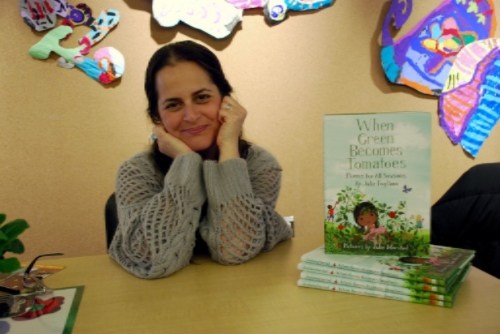
What is your favorite season and why?
I don’t have a favorite season. I really love them all. (Except when winter drags on too long or when summer is 1000 degrees.) Really, whatever season I’m currently in is my favorite season.
In your guest post at Watch. Connect. Read., you confess that you hadn’t intended to and were afraid of writing poetry. In fact, you don’t think of yourself as a poet:
Poets are supposed to be brilliant and intense, thoughtful, sensitive and a little mysterious. I’m not any of those things. I’m just sort of normal and a little too shy.
So, how did a supposed non-poet end up writing such a marvelous collection of poems?
For years, I was trying to write children’s books. Trying and trying and I think, at a certain point, trying too hard. Then I had kids and was overwhelmed and frustrated and stopped writing completely.
About 8 years ago, my friend, George O’Connor, came to visit. He is an illustrator and a writer I had met years before when we both worked at Books of Wonder, a children’s bookstore in Manhattan. He knew of my struggles with writing and had heard me complaining about not having time to write and I think he just got tired of hearing about it. His birthday was that week and he asked that as a birthday gift, I give him one thought a day for one year. As he put it, “It can be a line or a page or a ten page manifesto. As long as it’s one thing a day.”
 I’m surprised, actually, that I even said yes to such a commitment. That’s very out of character for me. Especially because I had to send him whatever I wrote (and I was very private with my writing back then). But, I think the open ended-ness appealed to me. There was no assignment, I wasn’t expected to start a book or create a character and I didn’t have to worry about punctuation or grammar or any of the details that would usually trip me up.
I’m surprised, actually, that I even said yes to such a commitment. That’s very out of character for me. Especially because I had to send him whatever I wrote (and I was very private with my writing back then). But, I think the open ended-ness appealed to me. There was no assignment, I wasn’t expected to start a book or create a character and I didn’t have to worry about punctuation or grammar or any of the details that would usually trip me up.
So, I started writing these super short “thoughts” mostly about my life… the pancakes I made for breakfast, the random objects under my kitchen table, the bird outside my kitchen window. As my thoughts progressed, I discovered the joy of taking words away. I discovered how satisfying it was to write as simply as possible. I started using line breaks in different ways. I guess I was slowly turning my thoughts into poetry, but I had no idea I was doing it.
 My first book, and then it’s spring, was thought #126 and my second, if you want to see a whale, was thought #280. After whale was signed with Neal Porter, he asked what else I had lying around and I sent him a huge chunk of those “thoughts” figuring maybe he would see something in one of them that I couldn’t see. But, after reading through them, he called and said that I had the start of a poetry collection. Of course, I laughed and said “I don’t write poetry!!” and he said, “Call it what you want, this is poetry.” So, from then on, (and after lots of hand wringing and panicking) I wrote poetry.
My first book, and then it’s spring, was thought #126 and my second, if you want to see a whale, was thought #280. After whale was signed with Neal Porter, he asked what else I had lying around and I sent him a huge chunk of those “thoughts” figuring maybe he would see something in one of them that I couldn’t see. But, after reading through them, he called and said that I had the start of a poetry collection. Of course, I laughed and said “I don’t write poetry!!” and he said, “Call it what you want, this is poetry.” So, from then on, (and after lots of hand wringing and panicking) I wrote poetry.
Have you always been intimidated by “poets” and poetry in general? Did you read poetry as a child?
As a kid I read Shel Silverstein. That was the extent of my poetry reading. But, WOW did I love him. I must have read Where the Sidewalk Ends and A Light in the Attic cover to cover, 100 times each. But, other than that, poetry was a school thing and didn’t really hold any interest for me until I was a teenager.

In English class, we were given the Norton Anthology of Poetry which is thousands of the thinnest, almost rice paper, pages of poetry. And I would sit in study hall reading through it half in awe and half in total terror. For the most part, I had no idea what anyone was talking about and that scared me.
In class, when we would have to break down a poem and discuss it, there would be kids with their hands up and waving in the air, talking up a storm. But, I always hid in the back of the classroom. I felt like I was missing the secret poetry decoder that everyone was given at the secret poetry club. But, the interesting thing about it and where the awe came in, was that even though I couldn’t articulate, line by line, what a lot of these poets were talking about, on an intuitive level I understood. Somehow, even though the meaning of the words seemed out of reach, the feelings were obvious to me. The fact that someone could take a handful of words and put them together in such a way that the emotion and beauty could rise up, way above the literal meaning… that really blew me away.
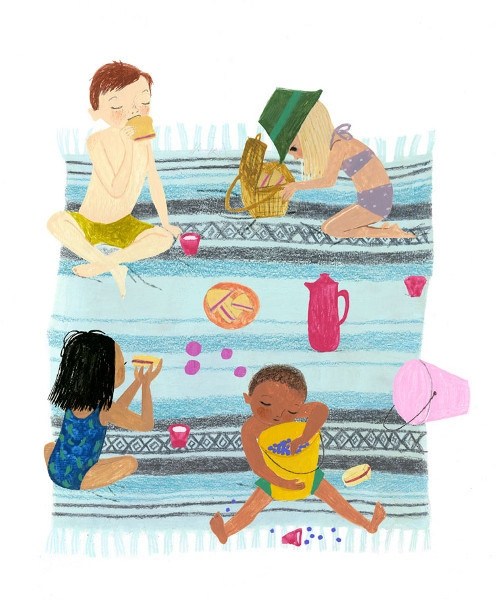
When Green Becomes Tomatoes certainly proves that you have the soul, sensitivity, and observational powers of a poet. When you began recording “tiny quiet things” about the natural world, did you think, in the back of your mind, that any one of them might be the seed for a picture book?
A seed, yes. But did I think that any of them would become a book on its own? Definitely not. When I wrote and then it’s spring it didn’t even cross my mind that it could be a book. I didn’t see how it could be. (It was about waiting for grass to grow!! How boring is that?! ) But, I sent it to Erin Stead (also a friend from Books of Wonder) because it was inspired by something on her blog and I thought she would appreciate it. Little did I know, she would send it to her editor (Neal Porter) and that they would take that thought about waiting and wondering and worrying and turn it into the most beautiful book I had ever seen!
Some might say that the spare, lyrical texts of your first two picture books are a form of poetry, that like the poems in your new book, they are both economical and beautiful. Have your feelings about what constitutes poetry changed as a result of writing Tomatoes, and if so, how?
As my very wise, poetry professor cousin once said, “To me poetry is about economy and beauty”. Once I heard that, my perception of poetry totally shifted. Now, whenever I get intimidated and nervous and caught up in the poetry-ness of it all, I think… economy and beauty… economy and beauty…

What was the revision process like for this book? Were many poems cut, or did you have to write additional ones to round out the collection? Were there any noticeable differences in how you approached the revision of individual poems vs. revising a picture book text?
Before I consider something finished I have to perfect it down to the last syllable. When you’re writing something only 4 lines long there’s no room for the tiniest misplaced word. So, before anyone else even sees it, I’ve tweaked and perfected to the absolute best of my ability. Sometimes I need another set of eyes to tell me when something isn’t working (or that I’ve made a totally embarrassing spelling mistake!) and Neal is certainly the man for that. And that goes for the picture books as well as the poems… same process.
When I gave the thoughts to Neal, I had written enough for half of the collection. So, I definitely needed to write a bunch more. And once I knew I was writing a poetry collection, I spent a bunch of time freaking out. Luckily, I was just about to have a baby and I had a good long break, and tons of time to rearrange my thinking before I started officially (and intentionally) writing poetry.

Some of the parenthetical phrases and the use of lower case letters in your poems remind me of E.E. Cummings. Who are some of your favorite poets?
Well there’s no way that I can deny being a huge fan of e.e. cummings. Who isn’t?!! Of course, the use of lower case letters, on some level is a nod and curtsy to him. (For years, I slept with one of his books next to my pillow, so how can it not be!) But, I also started writing like that as a way to remove obstacles. I needed to just get myself writing, without excuses, without worrying about how on earth to use a semi colon.
Truthfully, none of that was an intentional, stylistic choice. I wrote my thoughts that way for George, but didn’t realize that someday, they would be published that way. And really, I have to give Erin (Stead) the credit for that. When and then it’s spring was being turned into a book, the use of lower case and the lack of punctuation was definitely questioned. But, she was adamant that they stay true to the spirit of the original text. I NEVER would have had the courage to fight for that. It was my first book and I probably would have done anything they asked me, no questions asked. So, I’m really grateful that Erin spoke up on my behalf.

As for my favorite poets, obviously e.e. cummings and absolutely Ruth Krauss. They were both so completely free… moving from side to side and back and forth and sometimes inside out. Neither of them went directly from A-Z and that’s what I loved and that’s what was missing in my own work.
In retrospect, all of my non writing years weren’t about my job or my kids… I was so tangled up in how and what I thought I should be writing, that I was totally out of touch with the kind of writing that was natural for me. I don’t think George realized how totally brilliant and life changing his “thoughts of the day” really were for me. But, they gave me a free pass to just write- however and whatever I wanted. And most importantly because I loved to (and because he would harass me and send nasty emails if I didn’t).
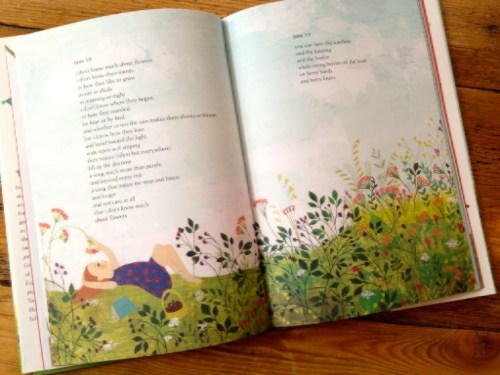
Please share a few of your reactions to Julie Morstad’s illustrations.
Hmm… well… I definitely cried a little. I’m not really much of a crier, but so far that has been my initial reaction to seeing illustrations for the first time. There’s something so intimate about having someone illustrate something that has only existed inside my own head for so long. I mean, that little girl is perfection and some of the scenes that she brought to life were eerily similar to the ones in my head. The poem where the girl is sitting in the living room… that is MY living room and my fireplace exactly. The placement of the windows… everything. It’s crazy! And none of those details were in the poems. But, in general, her illustrations are beautiful and sweet (without being too sweet) with just the perfect amount of that special Julie Morstad quality that I can’t quite explain, but that I love like crazy.

What are you working on now? Will you be writing more poetry?
Right now, I am finishing up a picture book that I am so super excited about. I guess it would be considered a poem, but it’s a lot more rhythmic and rhymey than everything else I’ve done so far. As for another book of poetry, I would LOVE to write a collection of Y.A. poetry. I’m just working up the courage…
Forthcoming books: Old Dog Baby Baby illustrated by Chris Raschka (Neal Porter/Roaring Brook Press, October 2016), When’s My Birthday? illustrated by Christian Robinson (Neal Porter/Roaring Brook Press, Spring 2017), and If I Was the Sunshine illustrated by Loren Long (Simon & Schuster BYR), pub date pending.
* * *
from SPRING

april 27
today
under a magnolia tree
i ran into a dachshund named paul
he was very much a sausage
with paws
and a nose
poor paul
if only he would look up
for a second
and notice the magnolias
with their pink
and their white
and their gentle flutters
he would soon realize
that it’s not so bad
to be a dog
tied to a tree
in the shade
when it’s springtime
and fluttering*
may 6
everywhere is chirping
and now there is purple*
may 10
lilac sniffing
is what to do
with a nose
when it is may
and there are lilacs
to be sniffed
*
from SUMMER

july 10
when green becomes tomatoes
there will be sky
and sun
and possibly a cloud or two
when green becomes tomatoes
there will be leaves
and flowers tall and standing straight
and someone splashing, jumping, diving down
when green becomes tomatoes
there will be wings
and something inching, green and small
and a sweetly, tweetly chirping song
when green becomes tomatoes
there will be round
and there will be red
and there will be tomatoes
(more red than green)
(more round than seed)
(more on the vine than way deep down)
when green becomes tomatoes
*
from FALL

october 31
pumpkin sprout
pumpkin shoot
pumpkin leaf
pumpkin rootpumpkin vine
pumpkin growing
pumpkin wander
pumpkin goingpumpkin orange
pumpkin winding
pumpkin ready
pumpkin findingpumpkin pick
pumpkin scoop
pumpkin seeds
pumpkin souppumpkin carve
pumpkin light
pumpkin glow
pumpkin nightpumpkin droop
pumpkin sink
pumpkin mush
pumpkin shrinkpumpkin toss
pumpkin out
pumpkin someday
pumpkin sprout
*
from WINTER
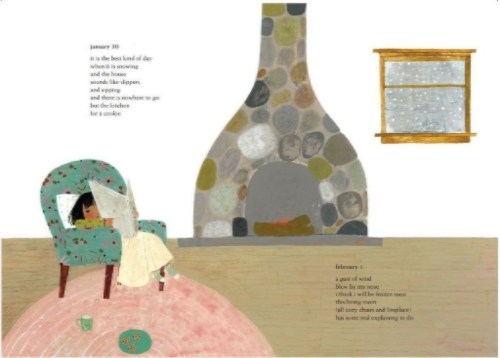
january 30
it is the best kind of day
when it is snowing
and the house
sounds like slippers
and sipping
and there is nowhere to go
but the kitchen
for a cookie*
february 1
a gust of wind
blew by my nose
i think i will be frozen soon
this living room
(all cozy chairs and fireplace)
has some real explaining to do
*
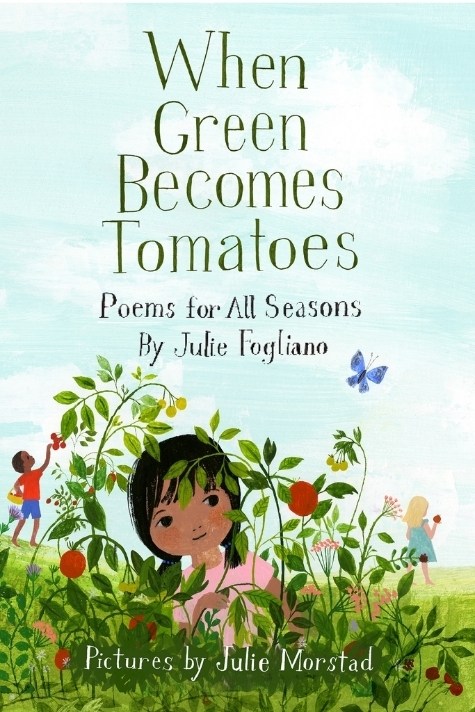
WHEN GREEN BECOMES TOMATOES: Poems for All Seasons
written by Julie Fogliano
illustrated by Julie Morstad
published by Roaring Brook Press, March 2016
Poetry Collection for ages 6-10, 56 pp.
**starred reviews** from Booklist, Kirkus, School Library Journal and Publishers Weekly
*
📗 SPECIAL BOOK GIVEAWAY 📕
For a chance to win a brand new copy of When Green Becomes Tomatoes, please leave a comment at this post telling us what your favorite season is, and why, no later than midnight (EST) Wednesday, April 6, 2016. You may also enter by sending an email with “TOMATOES” in the subject line to: readermail (at) jamakimrattigan (dot) com. Giveaway open to U.S. residents only, please. Good Luck!
*
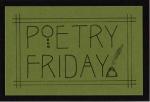 The beautiful and talented Amy Ludwig VanDerwater is hosting the Roundup at The Poem Farm. Take her some magnolia blossoms, tomatoes, pumpkins, and a cookie and check out the full menu of poetic goodies being shared in the blogosphere this week. Happy Spring and Happy Poetry Month!
The beautiful and talented Amy Ludwig VanDerwater is hosting the Roundup at The Poem Farm. Take her some magnolia blossoms, tomatoes, pumpkins, and a cookie and check out the full menu of poetic goodies being shared in the blogosphere this week. Happy Spring and Happy Poetry Month!
—————————————————————————–
Interior spreads posted by permission of the publisher, text copyright © 2016 Julie Fogliano, illustrations © 2016 Julie Morstad, published by Roaring Brook Press. All rights reserved.
Copyright © 2016 Jama Rattigan of Jama’s Alphabet Soup. All rights reserved.

My absolute favorite season is winter. I love snow and the cold, but most of all, I love the warmth and coziness of my home.
LikeLike
You sound like my husband. He enjoys the snow and cold weather. I agree with the warm and cozy part of being inside, though. 🙂
LikeLike
This is a beautiful and inspiring book! I loved the interview, and Julie’s humility.
I love each season but if I had to choose one, it would be spring- with it’s warmth, growth and implied hope.
LikeLike
Yes, when everything begins anew, and we can move forward with fresh hope!
LikeLiked by 1 person
I love this book and this interview so much. Thank you both! What a gift to read behind the scenes of WHEN GREEN BECOMES TOMATOES. Julie’s friendship with and birthday gift to George is a book of its own. (I don’t have a favorite season…I love all!) Happy National Poetry Month! xo
LikeLike
Yes, wasn’t the story about George the best? We should all have a friend like him. 🙂
LikeLike
I already own this book so I don’t need a copy, but it’s so lovely! Thanks for the post.
LikeLike
Glad you enjoyed the post, Kate. Happy Poetry Month!
LikeLike
Very special interview, very special author, very special poems! I’m sorry that I couldn’t be more eloquent, and that I’m so repetitive… but thanks! This was very special.
My season? Fall. I like spring too, but know that the heat of summer is coming and so are the bugs (which I should like, but don’t).
LikeLike
I know what you mean about Spring — there are some days that feel more like Summer (my least favorite season), so that dread of heat and bugs is already lingering in the back of the mind.
This is indeed a very special book written by a special author with a unique vision. I predict we will hear about it often during awards season :).
LikeLike
My favorite season … Spring. But this is a book for all seasons. Lovely book, lovely interview. Thank you, Jama!
LikeLike
Julie has found something extraordinary to tell about each of the seasons. Thanks for stopping by to read, Deborah!
LikeLike
Hello, Jama! I have been planning to order this book–just didn’t get around to it yet. It looks even better than I had expected. I think I’ll use it as a model to keep a poetry journal with my granddaughter Julia.
At the present time, she has been enjoying watching Classical Poetry, a poetry video created by the Poetry Foundation and HBO. Some days, she watches it three or four times.
Happy Poetry Month!
LikeLike
Hi, Elaine!! Always exciting to hear from you. Can’t believe Julia is already four — from the sound of it, she’s already quite a budding poet. How lucky she is to have your guidance :).
This book will blow you away. Hope you order your copy soon!
LikeLike
I have the book, Jama, so no need to put me in the drawing. After Julie’s first two books that I love, of course I had to get this one, too. It is lovely, and with Julie Morstad’s illustrations, one that will become a favorite. Thank you for the great interview. I love the story of “a friend named George”!
LikeLike
Yes, we’re all loving George for his friendship and foresight. Julie M’s illustrations are the PERFECT complement, aren’t they?
LikeLike
My girls and I would LOVE this book! My favorite season is Spring. Thank you for the wonderful giveaway.
Erin
ErinLoves2Run at gmail dot com
LikeLike
This is a book for all ages. A beautiful read aloud experience.
LikeLike
Thank you so much, Jama, for this one! I just read this book a week or so ago, having requested it from the library based on a facebook post by J. Patrick Lewis. I was so charmed by it that I immediately called my poet friend Tracie Vaughn Zimmer to rave about it. I love knowing more about how the book came into being and have even more admiration for the author and artist now. I love all the seasons too but I’m ready for it to stop being winter here in Colorado . . .
LikeLike
I was instantly charmed too — kept saying “wow” to myself all through. Simply stunning collection.
LikeLike
What a beautiful book! Thanks for introducing me to it. My favorite season has to be spring! It just doesn’t last long enough in my neck of the woods.
LikeLike
Fickle Spring — she doesn’t like to outstay her welcome. She flirts with us, phasing in and out.
LikeLike
I ADORE this book. A true poet is born.
LikeLike
Couldn’t agree more, Lee. ADORE is a good word.
LikeLike
Ooh, I love Julie Morstad’s illustrations; that curly hair looks so textured and adorable! I think this poet had me at “a tiny blue hello.” Crocuses after a rough winter are a gift of God, let me say. I love artwork and poetry that celebrates the seasons best of all – this is a buy for the nephews, but I think this also might be a keep for the book auntie!
LikeLike
You’ll definitely want your own copy. Love that tiny blue hello too. The poems are so unassuming that they are irresistible. Spare and lyrical always wins with me.
LikeLike
Thank you for the interview and introduction to the book. It was interesting to read about the back story…feeling inspired. My favorite season is Spring! I love the beauty in the newness of the world.
LikeLike
Sounds like everyone is happy Spring is finally here! Quite miraculous to see the green come back to the world.
LikeLiked by 1 person
I agree with Amy that Julie’s gift to George could be its own book. Fascinating story! How wonderful to be freed from thinking that you have to do something a particular way 🙂 (I don’t have a favorite season…they all have their charms.)
LikeLike
We all have those notions about right and wrong ways to do things. I think Julie has shown us the value of throwing off those shackles and writing as yourself, in whatever form feels most natural. Why do we put such unrealistic constraints upon ourselves?
LikeLike
Wow! THis is gorgeous. Thank you for sharing it Jama and Julie! My favorite season (in Florida) is winter because it is the only time Florida is cool and can be downright cold at times. My fave season up north was fall.
LikeLike
I hear you on why winter is your favorite season down in Florida. The heat can get very oppressive. Fall’s my favorite season here in Virginia. 🙂
LikeLike
Funny how so many of us share the picture of what a poet is supposed to be like! Fall was always my favorite growing up, but after I left I missed the reds. Luckily I have come to appreciate each season’s perks.
LikeLike
You’re right — how did we all get this notion about poets and poetry? The intimidation factor looms large, and that’s a shame because many people who are afraid of it or think it’s not for them are unnecessarily steered away from something they might truly love.
LikeLike
Wow. Such a refreshing, wonderful interview! Thank you both. I’ve been coveting this book… so, my favorite season is fall, before it gets too cold, all the aubergine and garnet and canary-yellow swirling, and the crisp air whispering, “School time! Learn something new!”
Cheers to Julie Morstad for these gorgeous illustrations.
And, “economy and beauty” – Amen!
[Happy Poetry Month, Jama – I look forward to catching up on your enticing posts these last couple of weeks!]
LikeLike
You’re a Fall girl, just like me (it’s Mr. C’s fave season too)! This is a good book to covet; you will NOT be disappointed after reading it!
LikeLike
We all need a George in our lives. What a great place Books of Wonder must have been. I love all the poems I read here, so free and delightful.
LikeLike
I agree — I wonder if we could order our own Georges online? 😀 Books of Wonder is still a great place — haven’t been there in awhile but it’s definitely magical.
LikeLiked by 1 person
I’ll have to look it up. Great interview. 🙂
LikeLike
Spring! Why? Green–flowers–birds, birds, birds! Thanks for the introduction to Julie’s book. Her writing seems so natural and unforced. I’ll order a copy for the library.
LikeLike
Yay! Glad to hear you’re ordering a copy. You will also want one for yourself after you see it. 🙂
LikeLike
I’ve heard so much about this book, I need to get a copy! Thanks for this interview, for allowing us to get to know Julie better. And I have to say, I think the pumpkin poem is my favorite one of those you shared!
LikeLike
Pumpkin Man! Glad you liked that poem. It’s hard for me to pick a favorite, though I do love the title poem as well as a winter poem about snowflakes falling. 🙂
LikeLike
Jama–I absolutely LOVE this book! It is such a gem, and beautiful on so many levels. Thank you for the lovely interview!
Without a doubt, autumn is my favorite season, especially autumn in New England where I grew up and used to live. I really feel so homesick in autumn for the crisp air, cornflower blue skies, golden-orange-magenta-burgundy leaves; for pumpkins and mums and gourds galore 🙂
LikeLiked by 1 person
Hi Maria! I have to agree whole heartedly with you — beautiful on so many levels. This one stands out from the pack hands down. Glad you enjoyed the interview. I also like Fall best :).
LikeLike
Wow! I can’t wait to read this book!
My favorite season is actually sandwiched right between two seasons. It’s on the cusp or like a twilight, halfway between two seasons. It’s right at the tail end of summer when it’s starting to get cooler and right at the beginning of fall when things are starting to get crisp (but haven’t started dying yet). It seems like a relief to reach it (I don’t like to get too hot!) because of the coolness and you can sense the change in the air, almost as if you can smell it. There’s also that sense of anticipation that follows it (school will be starting soon, there is the promise of leaves and snow falling).
LikeLike
Love your description of that in-between time when the air just begins to cool and you know Fall is on the way. Yes! Thanks Jena. 🙂
LikeLiked by 1 person
This books looks wonderful, and the illustrations are divine! I love fall best. Here in Georgia the summer is unbearable to me, and I nearly cry with relief when the nights start getting cool, the air crisp, the leaves crunch under my feet, the glorious colors everywhere. Time for hot chocolate, soup, hot tea, a warm blanket on the bed, the dogs frisking in the cool air. How I wish it were fall now!
LikeLike
I feel for you, as summer in Virginia is similar. I live in AC the whole time. Can’t bear the humidity especially.
LikeLike
The book looks gorgeous. I used to say my favorite season was fall, because I get to use this Gatsby quote:
“What’ll we do with ourselves this afternoon?” cried Daisy, “and the day after that, and the next thirty years?”
“Don’t be morbid,” Jordan said. “Life starts all over again when it gets crisp in the fall.”
But my true favorite is summer, because even though I wilt in hot weather, we get to have my teacher husband home. What’s better than having Atticus home, taking over all the meal prep for two months? 🙂
LikeLike
Sounds like a great trade-off. Wish Atticus did take out orders, or maybe you can hire him out?
LikeLiked by 1 person
Fall is my favorite season. Right now in Chicago, it is supposed to be spring, but there are white out conditions. Spring is too fickle for me. Thank you for the beautiful interview with Julie. I have checked this book out of the library twice already.
LikeLike
Good to know you also like the book so much! Sorry to hear about the fickle Spring weather. We’re in for a roller coaster week.
LikeLike
These books look unpretentious and inviting. Enjoyed reading about Julie Foglioan’s writing journey. Thanks for this inspirational post, Jama!
LikeLike
You’re right — her writing is unpretentious and very natural, making her observations very accessible to all ages. 🙂
LikeLike
I must own this book. Your interview — her words — Julie Morstad’s pictures — I’m convinced.
My favorite season is spring. In late January, I just can’t believe that green will ever return…and it always surprises me because it DOES!
But then again, my favorite season is fall. When I die, I want to go down flaming in several rich hues the way the sweet gum trees do.
LikeLike
Yes, you definitely MUST own this book! I’m with you on going down in Fall flames. 🙂
LikeLike
I recently read this book and fell in love with its simplicity and lyrical flutterings. It seems so light, yet touches so deeply. I feel that way about Julie’s other books as well. This interview was a real treat, Jama— thank you, both! My favorite season is spring. I’m enchanted by the greening of the trees.
LikeLike
Glad you like this book too! The greening of trees is always a miracle.
LikeLike
What a lovely book. Lee Bennett Hopkins reviewed it so positively on Facebook, I ordered it immediately. It’s simply beautiful.
LikeLike
Beautiful and then some. A rare book!
LikeLike
Thank you for sharing this wonderful interview, Jama. The beauty and simplicity of this book are jaw-dropping. The language of Julie’s poetry and the subtlety of the illustrations are sublime. As for me, I love fall. I think the coolness of the air after the heat of summer restores me in some way.
LikeLike
Good to know you like Fall best too, Catherine. The two Julie’s were perfectly matched. 🙂
LikeLiked by 1 person
This book sounds awesome! Great interview! 🙂 I like autumn – especially up here in PA – so many great colors! 🙂
LikeLike
Fall’s my favorite season too :)!
LikeLike
My favorite season is late summer!
LikeLike
Thanks for stopping by!
LikeLike
Lovely book and interview.
I have to say, Jama, that I am doing my first author interview soon and you know who I look to for guidance as to how to do it right? You. I so admire your blog and your conversations. Thanks for all the beauty and interest you share with us!
LikeLiked by 1 person
Thanks so much for the kind words, Jill! We have a mutual admiration society going. Love your reviews and roundups :). Looking forward to your interview!
LikeLike
Love the idea of a year of poetry. I have to choose spring, too. But it begins much earlier than most people think. We gravitate toward the warmer temps and forget to enjoy the little things that slowly pop! I would like this poetry book along with my 5 grandchildren. Thank you, Jama, for its introduction to my life.
LikeLike
Books like these remind us to be more observant of the world around us, so we don’t miss those small miracles signaling Spring and the other seasons. This is a beautiful book to share with your grandkids, Tam. 🙂
LikeLike
Thank you, Julie, for revealing the insecurities that we all feel but are afraid to admit. I’m thankful that George unleashed your inner poet! My favorite season is fall, and I am eager to see what you say about it in your poems. Thanks for a great interview, Jama!
LikeLiked by 1 person